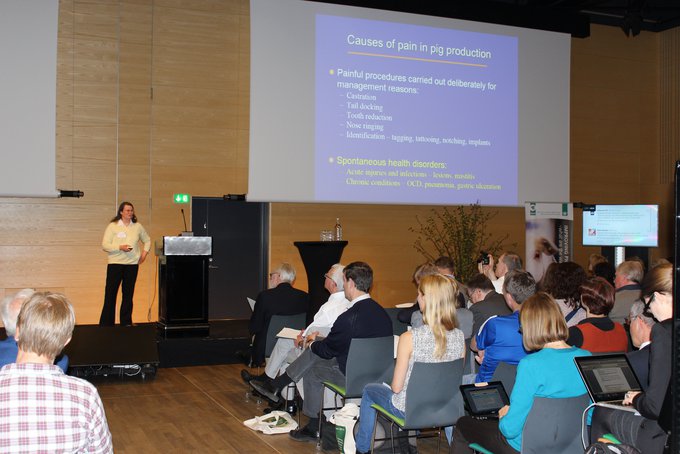



Improving Pig Welfare: Addressing Tail Docking
In pigs, an intact, curly tail may well be the most important animal-based welfare indicator, says the European Food Safety Authority (EFSA). It stands for both high quality management and respect for the integrity of the pig. It is obvious that a farmer who gets his pigs through to slaughter without tail docking or signs of tail biting must be managing a very good system. What is unfortunate, though, is that management of this quality is a rare occurrence, writes Melanie Epp from the 2015 International Conference on Pig Welfare, Denmark.Except in Sweden, Norway and Switzerland where tail docking has been banned outright, the procedure is still performed routinely in most European countries despite the EU ban in 2003.
In fact, a 2007 report found that the prevalence of docked pigs in Europe remained very high at more than 90 percent. Not much has changed since then, which is why tail docking was a hot topic at this year’s Improving Pig Welfare conference in Copenhagen, Denmark.
“Tail docking is intended to prevent animals from hurting each other,” says Sharon Dijksma, Minister for Agriculture in the Netherlands.
“But it is undesirable in terms of animal welfare. The procedure itself is painful for the animals, and it doesn't solve the problem that actually causes pigs to bite each other's tails.”
Animal welfare experts agree. Rather than eliminating the problem by eliminating the tail, the root causes of tail biting should first be addressed.
Professor Sandra Edwards of Newcastle University in the UK spoke on the assessment and alleviation of pain in pig production at the conference in Copenhagen. Tail biting, she says, has many causes, so pinpointing its roots can be challenging.

“We can find tens – if not hundreds – of different suggested contributing factors,” she says. “Genetics, nutrition, climate, health, competition and, very importantly, lack of proper enrichment.”
Although reducing risk to a manageable level can be challenging, she says, it is possible. One way is through genetic selection. “We know that tail biting predisposition has some heritable components and so we can select against it,” she says.
“But again we have some antagonism with desirable production traits, which we might have to sacrifice a bit in doing so.”
Edwards suggests that work needs to be done in developing better systems to predict when problems are about to occur. And researchers, she says, need to look for better ways to handle outbreaks when they do occur. If farmers can’t control the problem, they would rather not have it at all, she says. But if they have more control, they might be willing to accept a little more risk, she continues.
Controlling tail biting goes beyond genetics. The most important factor is enrichment, says Peter Stevenson, Chief Policy Advisor of Compassion in World Farming.
According to the EU Directive, pigs must have permanent access to a sufficient quantity of material to enable proper investigation and manipulation activities. EFSA has reviewed the science and agrees. According to a technical report they compiled in 2008, appropriate enrichment material may be defined as anything that stimulates exploratory behaviour for an extended length of time, preferably comparable to the level of occupation provided by straw.
“Sadly, many pigs in the EU are not given enrichment material or are given ineffective material, such as chains,” says Stevenson.
Enrichment materials should be complex, changeable and destructible. The best materials – straw, for example – will be a combination of edible, chewable, root-able and destructible. In situations where straw cannot be used, acceptable substitutes include hay, wood, sawdust, mushroom compost or peat.
“Farmers don't have to use all of these six,” clarifies Stevenson. “If something else is used it has to be as effective as those listed in achieving the outcome prescribed by the Directive.”

The provision of enrichment is not the only factor necessary to prevent tail biting. While enrichment is necessary, it is not on its own sufficient. Other elements that trigger tail biting must also be addressed, including the provision of good feed and nutrition, the prevention of excessive heat and cold, and insurance of good health.
“If these needs have not been met, a farmer cannot lawfully tail dock because he has made no attempt to first try and prevent tail biting by improving conditions,” says Stevenson. “If he has provided a good environment, but still has a biting problem the farmer can legally tail dock because he has been genuinely trying to prevent tail biting by keeping the pigs in good conditions.”
Stevenson is careful to note, though, that this does not mean that the farmer can tail dock indefinitely. “He's got to continue the attempt to try and prevent biting by improving conditions,” he says.
EUWelNet, the Coordinated European Animal Welfare Network has produced an excellent training tool for farmers and inspectors with detailed advice on how to comply with the Directive's provisions on the enrichment and docking. It's available in several languages.
"I really urge farmers and member states to use this,” says Stevenson.
The current recommendations might not be enough, though. Sharon Dijksma knows that, which is why she’s pushing for more research on the needs of pigs, especially in terms of space, diet and enrichment materials.
“Ultimately, though, my aim is a complete ban on tail docking,” she concludes.
To better understand the EU’s legislative requirements, as well as the problems and solutions related to tail biting, visit www.euwelnetpigtraining.org.
The tool serves two purposes: it helps to ensure that inspectors are correctly identifying problems and risks on the farm, and it helps farmers to make management choices so that at the very least the minimum standards are achieved.
July 2015








